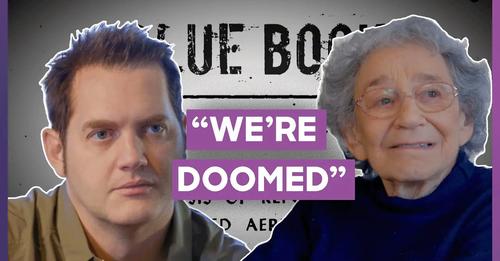
The mysteries surrounding Unidentified Flying Objects (UFOs) have long intrigued both the public and experts alike. Among the most compelling investigations into these enigmatic phenomena was Project Blue Book, a top-secret government program tasked with exploring thousands of UFO encounters from 1952 until its closure in 1970. A renewed interest in one of its most mysterious cases has surfaced, shedding light on an incident that has puzzled enthusiasts for decades—the 1965 Kecksburg UFO sighting.
In a recent exploration into this historic event, UFO investigator Ben Hansen delved into the archives and testimonies preserved by Jenny Zideman, the last remaining member of Project Blue Book. Jenny, who meticulously kept files on numerous UFO sightings, provided crucial insights into the Kecksburg incident, which occurred on December 9, 1965.
The small town of Kecksburg, Pennsylvania became the epicenter of intrigue when locals reported seeing a fireball tearing across the sky, eventually crashing into a nearby wooded area. Witnesses described the object as large, metallic, and acorn-shaped, surrounded by a haze of colorful lights—an anomaly that was later casually dismissed by the military as a mere meteor. However, those who saw it firsthand firmly believed it was something far more significant; a craft from another world.
Decades later, the event continues to evoke curiosity and speculation. Recent UFO sightings in the area, eerily reminiscent of the 1965 event, prompted Hansen to reexamine the original files with the help of Zideman. During their investigation, they also collaborated with UFO historian Mark O’Connell, and together they scrutinized a specific file that concluded the incident was caused by a meteor—a conclusion now widely criticized for its inadequacy in explaining the witnessed phenomena, such as the object’s apparent ability to change course in mid-flight.
Moreover, Hansen interviewed eyewitnesses like Ron Strubel and Bill Weaver, who not only confirmed the sighting but also described subsequent military activities that seemed to contradict the official explanations. Strubel, who was interviewed by Project Blue Book at the time, led Hansen to the crash site, offering a firsthand recount of the military’s rapid response and the mysterious proceedings that followed. Weaver’s account added to the intrigue, detailing a large military presence and the appearance of personnel in ‘moon suits,’ suggesting a recovery operation of something other than a mere meteorite.
These accounts fuel the debate about whether the government has been concealing the truth about UFOs. According to Zideman, such secrecy could indicate a vulnerability— an acknowledgment of our limited defense against more technologically advanced entities. This sentiment was mirrored in the eyewitness descriptions and the historian’s skepticism toward the meteor theory.
As interest in the Kecksburg incident rekindles, it begs a broader question: how much do we truly know about the objects that traverse our skies? Are they simply natural phenomena, or evidence of extraterrestrial visitations? While the government’s stance on UFOs has historically been one of skepticism and dismissal, cases like Kecksburg continue to challenge the official narrative, inviting us to consider the possibilities that lie beyond our current understanding.
The ongoing quest for truth in the realm of UFOs not only captivates the imagination but also underscores the need for transparency and rigor in investigating the unknown. As we stand on the brink of new discoveries, it is crucial that both the public and experts maintain an open dialogue, relentlessly seeking the truth hidden within the shadows of secrecy.


Leave a Reply